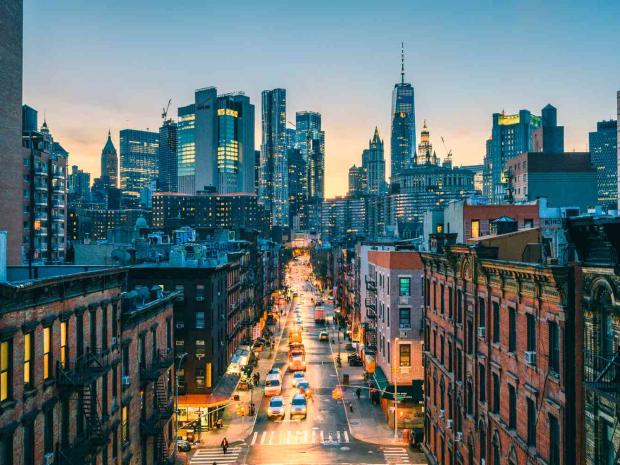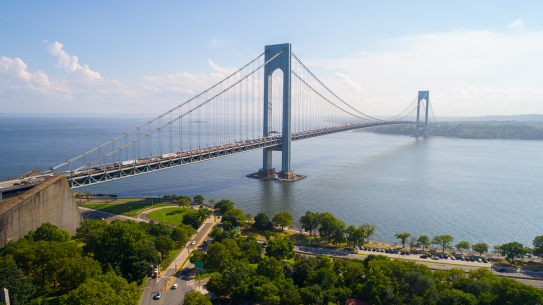Shaping New York City

Civil and urban engineering has been one of the core components of engineering at our school, dating back to the very founding 170 years ago. As New York City expanded around the school, our researchers, faculty and alumni have made key contributions to the shape and structure of this immense urban landscape. Read about just a few of the people who made their mark on the city.
The Holland Tunnel

Professor Edward J. Squire, class of 1910 and a faculty member of Polytechnic for 46 years, served as the head of the Civil Engineering department while advising on a number of large infrastructure projects. Of particular note was the Holland Tunnel, connecting Manhattan to New Jersey. When it was opened, it was the longest continuous underwater tunnel for vehicular traffic in the world.
Squire helped design the ventilation buildings, which allowed the tunnel — the first mechanically ventilated tunnel in the world — to bring in fresh air. That should be a relief to the 100,000 vehicles that pass through the tunnel each day, breathing easy thanks to the work of Squire.
Revamping NYC’s infrastructure
By the 1960’s, the city was creaking under the weight of an outdated, archaic building code that determined how every building should be constructed and maintained. Those codes had been written before World War II, and had failed to keep up with the myriad of advancements that had been made in the previous 30 years.
The 1968 NYC building code was led by Robert Moorman, head of the Department of Civil Engineering at Polytechnic since 1957. The major update took 7 years of work, came in at 1700 pages and weighed almost 15 pounds. It introduced rules for steel constructions, use of plastics, and new cements and allowed for buildings to take on new, wondrous shapes compared to the rectangular boxes that dominated the city. The new codes led to a boom in construction throughout the city.
Connecting the boroughs

Alumni Nomer Gray (‘43) was a partner at Ammann and Whitney. There, his team organized, administered, and coordinated the construction of the Verrazano Bridge, which connects Staten Island to Brooklyn. Construction of the bridge required 10,000 men and $325 million to complete — more than $3 billion adjusted for inflation. It was then the longest and heaviest unsupported bridge span in the world — 60 feet longer than San Francisco’s Golden Gate Bridge.
He was not the only community member to contribute to the project. Current faculty member John Falcocchio was a junior engineer responsible for the construction of the Brooklyn anchor foundations..
Gray would later go on to work on the Throgs Neck Bridge, which stretches across the Long Island Sound to connect Queens and the Bronx. Outside of the city, he would also help design Dulles National Airport, as well as major turnpikes in New Jersey, Ohio, and other states.
Reinvigorating the city’s transportation
Michael Horodniceanu, an alumni and faculty member, embarked upon a transportation career that included him serving as the New York City Traffic Commissioner for Mayor Ed Koch's administration from 1986 to 1990.
In 2008, he took on a monumentally influential and celebrated role: President of MTA Capital Construction. In that capacity, he oversaw a long list of challenging and ambitious projects, including the completion of the first phase of the long-awaited Second Avenue Subway, the construction of the new South Ferry Station, the openings of the Fulton Transit Center, and the ambitious extension of the Number 7 line. In addition, he completed 75% of the East Side Access initiative bringing Long Island Rail Road trains to Grand Central Terminal.
Prioritizing the environment
After serving in the Korean War, Raul Cardenas came to NYC and eventually earned a Masters and Ph.D. degrees from NYU in Environmental Engineering. He was a professor at the Polytechnic Institute of New York where he taught for many years. Raul put forth tireless efforts protecting the environment, including his authorship of the very first environmental impact statement in New York state.
Ensuring structural integrity
Carl Turkestra, a professor at the school, authored the Turkestra rule in the city’s structural code. The rule brought together methods to study the combinations of the effects of extreme events on structural systems, and was developed based on the theory of structural reliability.
Turkstra’s rule (Turkstra and Madsen, 1980) is a deterministic (non-random) procedure to formulate a load combination format for the design of structures subjected to the combined effects of several possible loading events. Along with other metrics, these methods are intended to calculate the probability of failure of a structure subjected to several transient loads and have been used to calibrate a variety of structural codes around the world, ranging from bridges, to buildings, to offshore platforms, to nuclear power plants, to transmission towers, to ships.
Making a C2SMARTER city
Our university’s reshaping of the city doesn't just exist in the past though. Take C2SMARTER, a Tier 1 USDOT University Transportation Center, which leads transportation research efforts at NYU and provides opportunities for students to work on real-world urban mobility problems.
The main research priority of this solution-oriented center is “Mobility of People and Goods in Urban Areas” with a focus on “Smart and Connected Cities.” Rather than just focusing on developing technologies to make a city smarter, C2SMARTER — led by Director and Founder Kaan Ozbay — is dedicated to a related critical step: how to connect these disparate technologies with cities of different population and infrastructure scales and different systems of systems.
Last year, the center received $15 million total commitment that includes $10 million from the U.S. Department of Transportation for C2SMARTER to continue its work as a Tier 1 University Transportation Center, leading a consortium of universities that will address the U.S. DOT’s priority for reducing traffic congestion.

